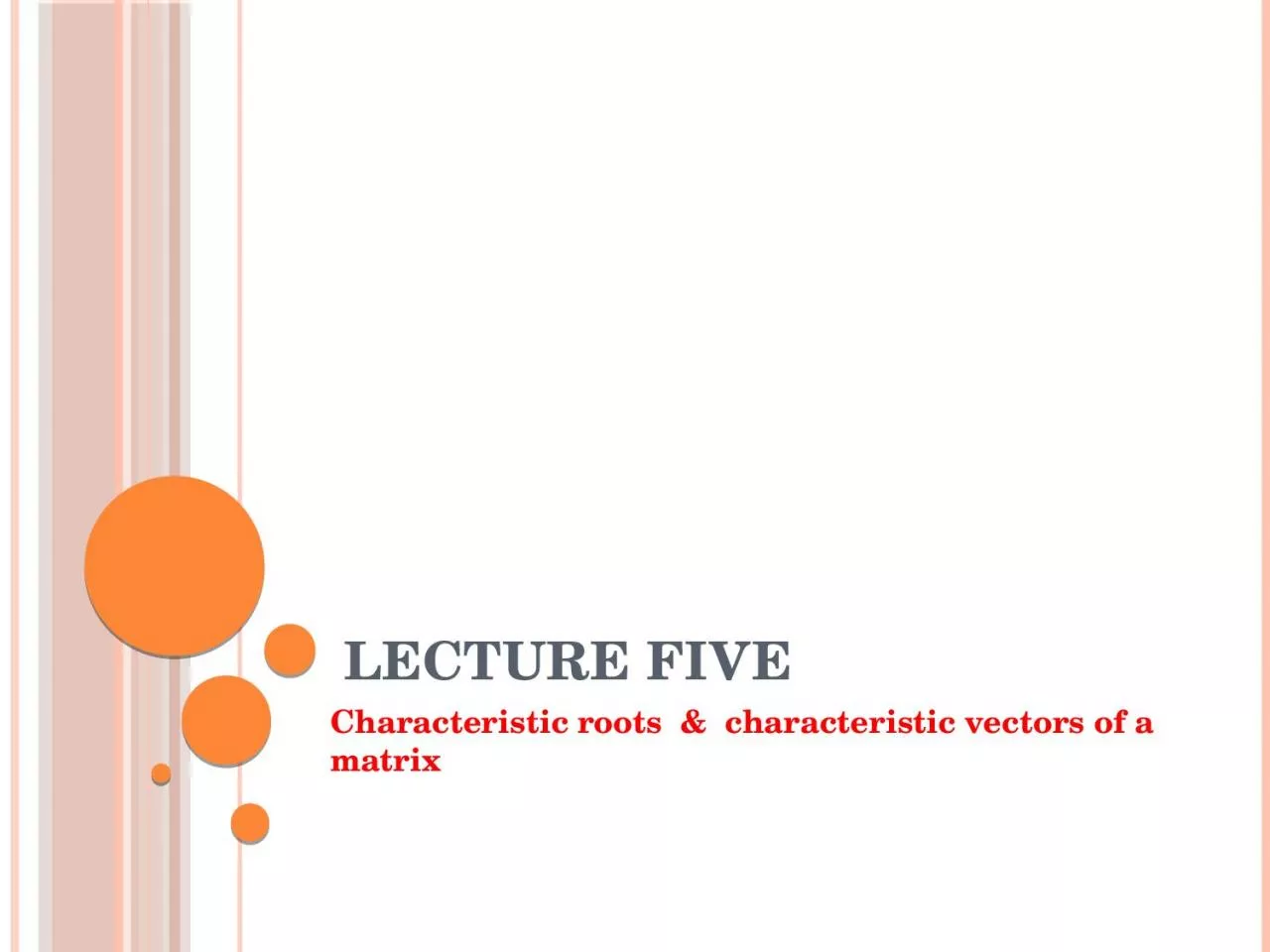

The characteristic roots of the pp matrix A are the solutions of the following determinant equation Laplace expansion is used to write the characteristic polynomial as Since ID: 1026557
Download Presentation The PPT/PDF document "Lecture Five Characteristic roots &..." is the property of its rightful owner. Permission is granted to download and print the materials on this web site for personal, non-commercial use only, and to display it on your personal computer provided you do not modify the materials and that you retain all copyright notices contained in the materials. By downloading content from our website, you accept the terms of this agreement.
1. Lecture Five Characteristic roots & characteristic vectors of a matrix
2. The characteristic roots of the (p×p) matrix A are the solutions of the following determinant equation: Laplace expansion is used to write the characteristic polynomial as:Since (Si) is the sum of all (i×i) principal minor determinant, then:
3. Associated with every characteristic root(latent , eigen, proper) : λi of the squre matrix A is a characteristic vector xi whose elements satisfy the homogeneous system of equations:
4. Properties of Characteristic Roots and Characteristic Vectors The characteristic roots of a positive definite symmetric matrix A are all positive(λi > 0), i.e.; there are p non-zero characteristic roots.The characteristic roots of a positive semi-definite symmetric matrix A are (λi ≥ 0), i.e.; p non-zero characteristic roots and (n-p) zero.For any positive definite symmetric matrix A, the characteristic roots of (A-1) are the reciprocal of characteristic roots of (A).If we have the matrix (Ak) , (k is a positive integer) then, it has the same characteristic vectors of (A) , i.e.;is the characteristic root of (Ak) , where is (λi) is the (ith) characteristic root of (A).
5. For every real symmetric matrix (A), there exists an orthogonal matrix (P) such that: D = P'AP where: D is the diagonal matrix of the characteristic roots of (A). The normalized characteristic vectors of (A) can be taken as the columns of (P) , such that: P'P=I.Any real quadratic form (Q.F.) can be reduced to a weighted sum of squares by computing the characteristic roots and vectors of its matrix, such that: x'Ax = y'P'APy by using the orthogonal transformation : x=Py where is: x'Ax = y'Dy = λ1y12 + λ2y22 + …+ λryr2
6. Where is: λi are the characteristic roots of the coefficient matrix. r is the rank of the form.The characteristic roots of an idempotent matrix (AA = A) are either zeros (0) or (1) ones and a quadratic form with such a matrix can be reduced to a sum of ( r ) squared terms. If (C) be the matrix whose columns are the (n) independent characteristic vectors of (A) then: B = C-1AC be the diagonal matrix with characteristic roots of (A). i.e.C: non-singular (full rank)
7. If λi ≠ λj for a symmetric matrix (A) , their corresponding vectors xi & xj are orthogonal.If (A) is orthogonal matrix , then all of its characteristic roots have absolute value of (1) i.e. (±1).If λi > 0 , then x'Ax is positive definite and if λi ≥ 0 , then x'Ax is positive semi definite.The characteristic roots of (AB) are identical to the characteristic roots of (BA), i.e., r(AB) = r(BA) , as well as: tr(AB) = tr(BA). Furthermore; tr(ABC) = tr(BCA) Note: If the Q.F. is to be maximum then λ must be the greater characteristic root of A and x is associated vector. Similarly , if the Q.F. is to be minimum then λ must be the minimum characteristic root of A.